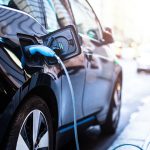New research found a new way of working lithium and combining it with other materials that altogether are capable of increasing the range traveled by electric cars and their charging speed.
According to the Market Allied Research, the global electric vehicle (EV) market was worth $119b in 2017 and forecasts are its value with reach $567b by 2025. At our smaller, more limited scale, those of us living in medium-large cities have probably realized there are more EVs being driven in the roads a little everywhere.
The global economy, driven by the need to grow continuously but also to manage climate change and the economic impacts and risks it brings along, has been adapting to the new demand for EVs as the best mobility solution.
Electric cars are, studies show, a far better choice than thermal cars and that’s why ecologists have been early-adopters despite challenges such as the lack of charging infrastructures or it’s the shorter driving range. But it looks like the latter is one step closer to becoming a problem of the old days.
The Need To Increase The Range Electric Cars Can Travel
Back to where we left: according to an Aviva survey, 81% of UK drivers assumed they being concerned about battery charge/range when thinking about purchasing an electric vehicle. This is also the argument often used by supporters of hydrogen fuel cell vehicles (FCVs). Because while most fully EVs can travel between 100-200 miles on a single charge, hydrogen ones can get to 300 miles, according to AutomotiveTechnologies.
However, the achievements made by Dr. Jung and his research team at the Center for Energy Storage Research of the Korea Institute of Science and Technology might be very useful for this issue.
Moreover, they also enable fast charging to more than 80% capacity in around 12 minutes. The team expects that when applied to electric cars’ batteries these can more than double their range. Let’s take a closer look at these findings.
Electric Vehicles Will Leave Graphite Materials Behind
The batteries commonly used in electric vehicles massively commercialized nowadays days use graphite anode materials. The problem is that these materials have a low energy storage capacity which ultimately leads to the shorter driving ranges (compared to thermal cars) we’ve discussed before.
This helps explain why silicon, which has an energy storage capacity up to 10 times higher than graphite, is becoming increasingly explored as a viable alternative as an anode material that can help to cover longer-ranges.
Not all is gold though. And among the reasons why this change (to totally replace graphite) is taking its time has to do with the fact that the volume of silicon materials expands quickly and its storage capacity decreases after some charging (and discharging) cycles.
These are precisely the challenges scientists have been focusing on as they try to get ahead in a market (of the global anode materials) that might be worth $10 billion by 2025. R&D is sometimes hard due to the complexity of the methods used but also cost-wise – with the anode being worth 10–15% of the total cost of a lithium-ion battery, according to c&en. Despite all this, it looks like Dr. Jung’s team had very significant findings.
New Silicon Composites May Give Electric Vehicles An Extra Range
To improve silicon’s stability, the team at the Korea Institute of Science and Technology focused on materials such as water, oil or starch. They mixed starch with water and silicon with oil and then mixed and heated both to produce carbon-silicon composites. According to the study’s abstract: the Si–C composite material is synthesized using a scalable microemulsion method by selecting silicon nanoparticles, using low-cost corn starch as a biomass precursor and finally conducting heat treatment under C3H6 gas.
This simple thermal process successfully fixates the carbon and silicon and prevent the silicon anode materials from expanding during charging cycles. According to the authors, the composite materials (technically called Si-C hybrid composites) end up having a four-time greater capacity than graphite anodes (360mAh/g – 1,530mAh/g), “stable capacity retention of 80% over 500 cycles and a fast charge-discharge capability of 12 minutes”.
According to Dr. Jung, the simplicity of the processes used and the excellent properties of the composites developed will likely be commercialized, mass-produced and used for EV’s batteries and other energy storage systems, Phys says.
[Image credits to Guteksk7 on Shutterstock]

